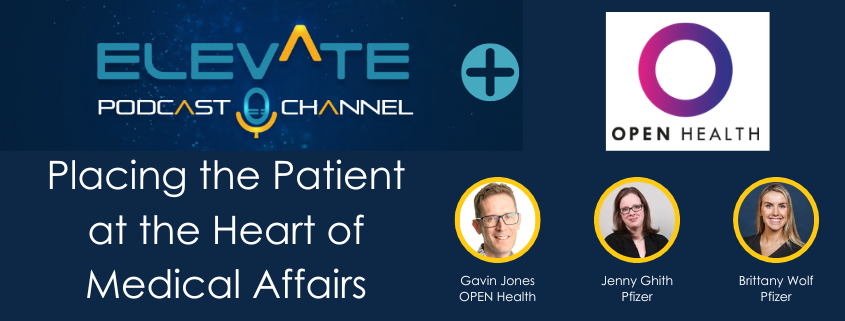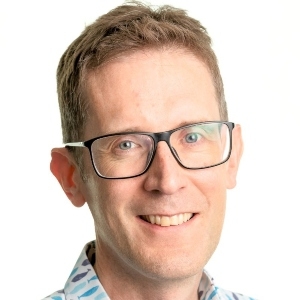Placing the Patient at the Heart of Medical Affairs
Speaker: Gavin Jones
Speaker: Jenny Ghith
Speaker: Brittany Wolf
Patient communities continue to mobilize and play an increasingly important role by influencing many elements of the drug development journey and subsequent patient access and support activities. This input ranges from natural history studies, recruitment in clinical trials, understanding burden, contributing to Health Technology Assessments and co-creating educational resources that enable shared decision making and adherence support. Given Medical Affairs stakeholders have similar reach across drug development and commercialization it is logical that this function plays a central role in an organization’s patient-first thinking and strategy. To achieve this, Medical Affairs stakeholders will need to develop thoughtful and impactful strategies that not only build the trust of patient communities but also their internal colleagues. Here we discuss patient-centricity strategies and actions with Gavin Jones, Global Advisor Rare Disease, OPEN Health, Jenny Ghith, Senior Director, Omnichannel Strategy and Innovations Lead, Pfizer, and Brittany Wolf, Director, Patient Centricity Lead, Pfizer.
Following is an automated transcription provided by otter.ai. Please excuse inaccuracies.
Garth Sundem 00:00
Welcome to this episode of the Medical Affairs Professional Society podcast series: “Elevate”. I’m your host Garth Sundem, communications director at MAPS. And today we’re speaking with Gavin Jones, Global Advisor of Rare Disease OPEN Health. Jenny Ghith, Senior Director Omni Channel Strategy and Innovations Lead with Pfizer, and Brittany Wolf, Director, Patient Centricity Lead, also with Pfizer. This episode is sponsored by OPEN Health. Content for this discussion reflects the collective experience and opinions of the presenters and is not intended to represent the past or current views of Pfizer, or OPEN Health. So first, welcome, everybody. And, Jenny, I was wondering if you could please get us started by talking about the post pandemic. I wish it was all post pandemic publications landscape. So what is the world like now?
Jenny Ghith 01:03
Oh, great question. I think we all can relate to complexity, particularly in terms of information we’re receiving across many channels. And imagine the amplification of this effect. If you’re patients and you’re looking for information in the face of an illness, a chronic disease, or cancer. I think this is only exacerbated and increased the disruption that we’ve been feeling already, particularly in communications, public scientific awareness is heightened as well. And I think that’s wonderful. There’s more interest in science and breakthrough science than we have seen. But again, we still receive more information than ever digitally. And we all spend almost seven hours online, I read that in a survey, our attention spans are shorter than ever. And gaps still remain for some of us, you know, I think we take for granted that we all have access to the internet, not everyone has broadband access everywhere. So we need to be responsible and thoughtful and how we speak. And we also need to think about misinformation that’s out there. Many of us are utilizing multiple platforms in science now. And social media is one of them. 1/3 of posts sometimes can contain misinformation. Again, just imagine all this if you’re a patient.
Gavin Jones 02:30
And I think Jenny makes some really interesting points around, you know, the increase in patient ownership of their own health outcomes. And I really feel that, you know, that is, is is in tandem with a mindset evolution that’s continuing within the pharmaceutical industry, and within Medical Affairs teams around the recognition of value that the patient community can bring in terms of the development and delivery of Medical Affairs tactics, whether that’s understanding what outcomes are meaningful for patients, ie what are the man? What are the math the moments that matter most to patients? And how can we align our new therapies value propositions around that understanding the patient journey, understanding the emotional and physical journey that patients are on from diagnosis through to management of their condition, and finally understanding the burden to them, to their families and to society as a whole, in living with these conditions and how new therapies can alleviate some of those.
Garth Sundem 03:36
Okay, so we want the patient perspective in Medical Affairs. Brittany, how do we involve patients in a two way dialogue?
Brittany Wolf 03:46
Yeah, that’s a great question. You know, when we’re engaging patients, we truly have to focus on meeting patients where they are, we must engage with them to evaluate where they currently go for information, in what format they prefer that information to be presented and how they digest that information. As an industry, this would be focused on accommodating various learning styles and languages, as well as also performing assessments on various platforms used by different communities. We really must also be sensitive to the need for open access, which has been a consistent focus in recent years and providing patients and their families with that information information that they need at the right level. As a whole, we really need to be careful not to make assumptions about what they need and how they need it. And really, the only way to learn and adapt to these variations is to be equitable and have a two way dialogue like you said, directly with these communities and illustrate that we are carrying this feedback through in our resources. With that being said, we are certainly in unchartered territory, and expanding this area of Medical Affairs because historically, patient content was owned by commercial with plain language summaries and other scientific resources that are intended for lay audiences. This is evolving into a medical activity as well which adds complications, of course to the mechanisms of approval. To create and distribute this content.
Garth Sundem 05:03
Okay, well, so we’re involving patient communities and I hear you say, going to these organizations, I know that’s an important piece of this. So how do we do this? compliantly? Jenny?
Jenny Ghith 05:15
You know, I think it’s an important question, because we want to be responsible in what we’re conveying. And again, we want to be mindful of the landscape and all the issues with trust that are out there and misinformation. How do we be compliant? Well, we, we look to our experts in our collaborators that are companies, right, we need to talk to them, we all certainly want to dare to try. And we want to be courageous in our communications. And we want to be impactful and do the right type of communications to meet the patients where they are. But to do so in a way that works and then is meaningful, but also responsible is important. So talk to your cross functional colleagues, early in the stage of development, make sure you involve them as you go. And then, you know, I think sometimes they also hear about, they hear these activities, and we get them approved. And they want to know what the outcomes are too. And they want to understand the impact of what we’re doing. So make sure we follow through. So that then we can continue to advance the work that we’re doing together.
Garth Sundem 06:25
Okay, so we have a complex publications landscape that more and more is speaking directly to patients and with patients compliantly. So that is where we are. Where are we going Gavin, what do you see in the future of this publications landscape?
Gavin Jones 06:42
I think it’s a really exciting time, Garth, I think we’re going to see continuing growth of collaboration and co creation, with patient communities. And those that advocate for them, I think we’re gonna see, as Jenny suggests more cross functional collaboration within organizations as well. And I think we need to recognize the power of the collective and supercharge our solutions by involving both medical and patient writers, because then you’re going to achieve scientific accuracy, alongside health understandability. So ensuring that the content you develop can truly be understood by the stakeholders you’re trying to reach. And I think in addition to that, getting the tone of voice right is really, really important to ensure that we, that we meet the needs of the communities we’re trying to serve, and thoughtful collaboration with these communities. And it’s really down to simple things about how we communicate with them, how we co create with them, even how we dress and act in front of them. All of these things will build trust and collaboration with patient communities.
Garth Sundem 07:55
Let me just follow up on one thing real quick, you said involve patient writers, you said involve medical and patient writers. Do you mean involving writers from patient communities? What did you mean by that?
Gavin Jones 08:06
That’s a really good question, Garth. What I meant by that was an expert experience in lay language writing, working alongside a medical writer. In this way, you will ensure scientific accuracy with lay understanding. Even with this combination, we would still recommend validating the writing with the patient community before publication.
Garth Sundem 08:28
Okay, but Brittany, what do you see developing here? What is the future of publications?
Brittany Wolf 08:33
Absolutely. I think that, you know, we’ve been seeing an increase in plain language summary development, which is fantastic and enhanced content, to really, really facilitate that learning of what the publication is trying to convey to the patient community. But I think another area that’s really again, unchartered territory and Medical Affairs is scientific patient education to complement those publications. So this is really focusing on understanding the clinical trial process, how to interpret an abstract or manuscript, what are frequent terms used in clinical trials, what is a Congress meeting, really understanding those topics and taking a step back so that the patient fully understands everything we’re conveying to them, instead of just providing a data dump of information? You know, I really think that having that fundamental knowledge really helps patients make sense of the results discussed in those publications, and really to have them, you know, enable them to have a more active and competent dialogue with their physician as a thought partner.
Garth Sundem 09:28
That’s interesting. Right now we have publications paired with kind of external education activities that are aimed at providers and key opinion leaders. Are you saying that in the in the developing publications landscape, we should be looking at external education activities aimed at patient communities?
Brittany Wolf 09:51
Absolutely. I think traditionally, a lot of these activities you know, really targeted lifestyle topics and how to live well with their disease. But patients want a little bit more than that if they’re interpreting these publications and really want that data, I think we need to take a step back and not assume that they know what every component of the publication means. This will really, you know, these are separate resources developed, but they are, they could definitely be used alongside of publications and plain language summaries, and physicians can feel empowered then to distribute that to their patients so that they feel more confident in making a decision about their treatment plan.
Gavin Jones 10:26
Yeah, Brittany makes really good points there. I think, from my perspective, it’s, it’s ensuring those those resources are available to patients. But it also just making sure that we were mindful when we’re developing healthcare professional educational resources that they ask coterminous. And by that, I mean that, you know, both sets of resources, help both stakeholder group have better more informed consultations, which leads to better shared decision making for individual patients.
Garth Sundem 10:59
Jenny, what would you add about the future of publications?
Jenny Ghith 11:04
I think what Brittany and Gavin have stated is really important. But what I’m also hopeful for is that we really continue to understand patients more, we need to really try to approach them and speak with them and make sure we’re developing appropriate solutions that serve their needs. And the only way we’re going to do that is by having dialogue with them. And ultimately, hopefully developing more personalized solutions for them, so that they can go and find all these wonderful pieces that we’re developing to. So, you know, I think as we start as we continue to think about what we want to do, we shouldn’t rush to conclusions. Try to try to ask the right questions, really work on your discovery phase, make sure that you’re truly writing for patients right with your audience, that it really resonates with them. And those are things I think that we’re only going to get better at over time.
Garth Sundem 12:05
Shared decision making. In a landscape rife with misinformation, I can see why publications and other Medical Affairs education activities are extremely important in this post, pandemic world. Well, let’s leave it at that for today. Thank you, Gavin, Jenny and Brittany for joining us. To learn more about how your organization can partner with OPEN Health visit OpenHealthGroup.com. MAPS members, don’t forget to subscribe. And we hope you enjoyed this episode of the Medical Affairs Professional Society podcast series: “Elevate”.






